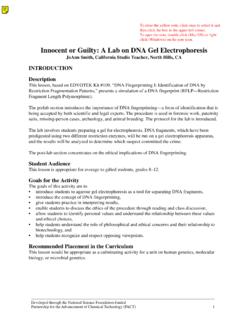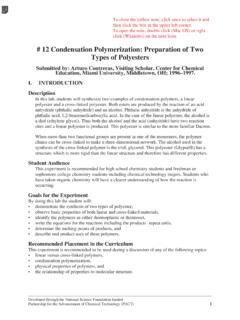Transcription of Atomic Absorption Determination of Zinc and Copper in a ...
1 To close the yellow note, click once to select it and then click the box in the upper left corner. To open the note, double click (Mac OS) or right click (Windows) on the note icon. Atomic Absorption Determination of zinc and Copper in a Multivitamin Carol White, Athens Technical College, Athens, GA. Background Atomic Absorption spectroscopy (AAS) is an important analytical technique based upon the Absorption of radiation by free atoms. Virtually all metallic elements can be directly detected with excellent accuracy, precise quantitation, and very sensitive detection limits. This technique can also be used to indirectly detect and measure the amounts of some nonmetallic elements.
2 Atoms of each element in the ground state have a specific electron configuration. These atoms can absorb quanta of light energy when that energy exactly matches the energy associated with any of the allowed electronic transitions within that atom. (See Figure 1.) Atoms that absorb energy are said to be in an excited state. Their electrons absorb exact quanta of energy, elevate to higher energy levels, and then fall back to the ground state, emitting photons of light. This emitted light has a specific wavelength, since it corresponds to the energy released when the electrons fall back down to the ground state. This wavelength corresponds to the energy of one of the allowed transitions within the atom.
3 The light emitted, therefore, produces an emission spectrum consisting of specific wavelengths visualized as Frauenhofer Lines. 6 5 energy above ground state, J x 10 19. nm nm nm nm 4. 3. 2. nm*. nm*. nm*. nm*. 1. 0. Figure 1: The major energetic levels in a potassium atom. Adapted from Braun, Instrumental Analysis;. McGraw-Hill: New York. 1987; p 176. The transitions with asterisks are those that are normally used for AAS. Developed through the National Science Foundation-funded Partnership for the Advancement of Chemical Technology (PACT) 1. Collection of Laboratory Activities: Atomic Absorption Determination of zinc and Copper in a Multivitamin Two closely related spectroscopic techniques are commonly used in analytical laboratories to measure the light absorbed and emitted by atoms.
4 These are emission spectroscopy and Absorption spectroscopy. Emission spectroscopy measures the light emitted by the electrons as they descend back to the ground state. On the other hand, Absorption spectroscopy measures the original Absorption of energy by ground-state electrons. Since many more atoms are in the ground state than in an excited state in a sample at any one time, Absorption measurements are generally more sensitive than emission measurements. In addition, relatively few factors interfere with Atomic Absorption measurements, and it can be used to quantitate elements in many types of samples. AAS has been widely used in medicine for the analysis of trace metals, metal toxicology determinations, and even in forensic pathology studies.
5 Modern medical concerns over environmental mercury and lead poisoning, as well the ingestion of nutritionally required metals at toxic levels, are reflected in the effective use of Atomic Absorption analysis. Coupled with x-ray electron microscope analysis of metals in solid samples, Atomic Absorption has been a useful tool in metallurgy, especially with the advent of highly complex modern metal alloys. Since Atomic Absorption is relatively inexpensive and fast and requires only a minimum of proper laboratory training, it is an excellent technique for performing first-run analyses of industrial metals. Similarly, soils analysis has benefitted greatly from the use of this technique.
6 Farmers, homeowners, and horticulturists desire soils containing optimum levels of primary nutrients, macronutrient metals, and trace elements. Soils are ideal for Atomic Absorption since the particles are already in a finely ground state and often are composed of water-soluble metal salts that lend themselves readily to atomization and analysis. Soil additives can be analyzed using these same techniques with a precision that allows the person in the field, whether a farmer, landscape architect (or designer), or homeowner, to apply the exact amounts of the nutrients necessary to obtain a balanced soil composition for the specific plants to be grown.
7 Atomic Absorption is applied just as easily to industrial process analysis. It is effective in detecting contaminants in petroleum refining and distribution so as to prevent the inclusion of unwanted metals in exhausts that would pollute the environment. In the past, this technique was widely used in the quantitation of tetraethyl lead antiknock agents in gasoline. The same procedures are now used with great success to detect the by-products of burning this gasoline, in the form of lead residues on the shoulders of highways, in adjacent plant and animal tissues, and in the ecosystems contaminated by this formerly useful material.
8 This example is just one of many where industrial chemical processes have used and, in many cases still do use, Atomic Absorption on a broad scale. It is also an example of how the same techniques can be just as easily applied to detect many environmental pollutants. The results of these analyses often impact our lives in terms of the environmental effects, the medical toxicology, and even the political machinery generated to tackle problems generated by metal contamination. Food in the United States and in much of the world is commonly analyzed for the presence or absence of a variety of substances both required nutrients and undesired contaminants.
9 AAS plays a role in many of these analyses because of its relative ease and relatively low cost. As in soils analysis, marketers desire agricultural produce that have the correct levels of elements that are nutritional requirements and do not have elements that may be toxic or unnecessary. For business as well as health reasons, farmers and grocers have specific concerns that can be addressed effectively using Atomic Absorption analysis. Developed through the National Science Foundation-funded Partnership for the Advancement of Chemical Technology (PACT) 2. Collection of Laboratory Activities: Atomic Absorption Determination of zinc and Copper in a Multivitamin Forensic pathology uses a tremendous variety of analytical techniques, many of which are unfamiliar or unknown to the typical citizen.
10 It is often necessary to analyze samples that are taken from the most unsanitary of sources so as to determine the presence of toxic metals. Even the examination of bullets, gunpowder, and crime residues frequently involves the analysis for specific metals in order to determine sources of these materials or to match them with similar materials obtained in criminal investigations. Coupled with other analytical techniques, AAS can help a modern forensic pathologist determine exactly where a specific bullet, cartridge, or metal blade was produced, even to the point of the specific date or industrial run that produced the material. Atomic Absorption has continually proven to be one of the most reliable and effective of these crime-fighting tools.






